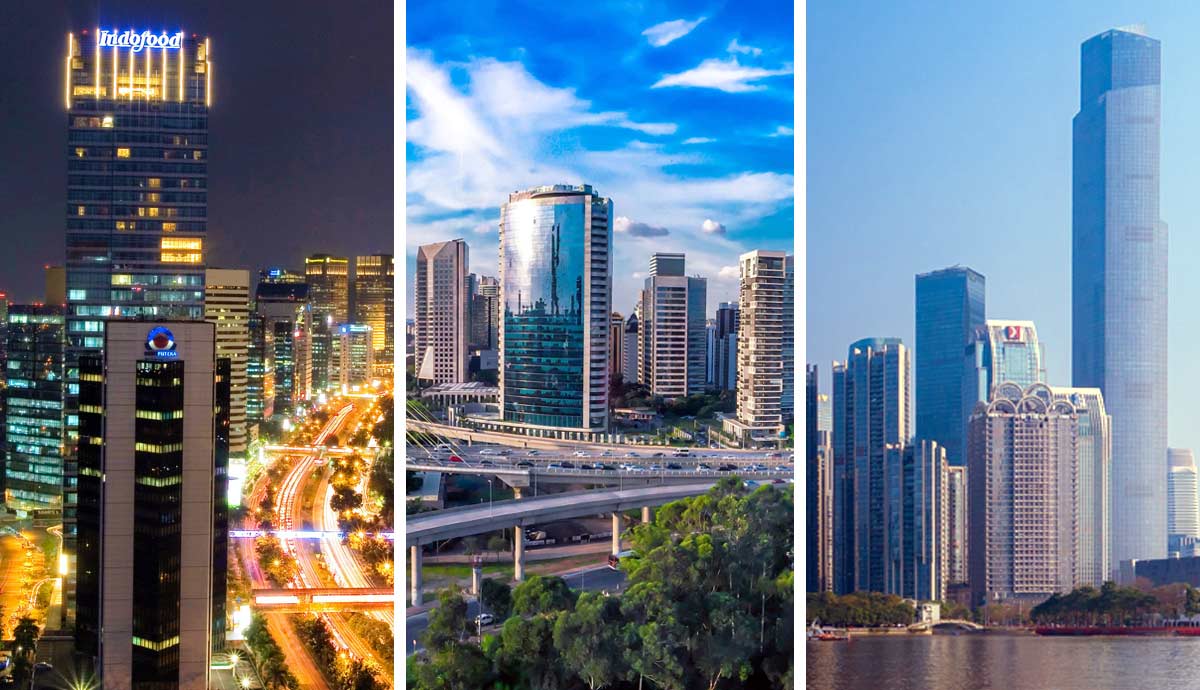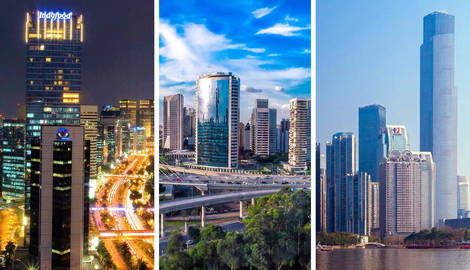
Between 13,000 and 14,000 years ago, an extraordinary thing happened in human society. Hunter-gatherers started to slowly adopt a less nomadic and more sedentary lifestyle. Exactly why this happened is subject to debate, but it was certainly set in place by the advent of farming.
Villages cropped up, evolving into villages and towns, and then thousands of years later, into the first cities with many thousands of inhabitants.
Today, the biggest cities in the world are homes to tens of millions of people. The unprecedented scale of urbanization has created skylines that stretch as far as the eye can see, dwarfing their famed predecessors.
Determining the size of a city is a tricky thing. Generally, it is done by quoting the population, but this is subject to the definitions of what areas constitute parts of the city, and each country has its own methods and terminology to define the central urban area and the metropolitan surrounds. This makes it challenging to rank them.
Nevertheless, the largest cities are undeniably massive. Here are 6 of the biggest.
1. Tokyo

For a substantial part of its life, Tokyo was nothing more than a small fishing village on the southeast coast of Honshu, and for most of its life, the town was named Edo. During the Meiji Restoration in 1868, the seat of government in Japan was moved from Kyoto to Edo, which was subsequently renamed Tokyo.
With this newfound need to reflect its importance, Tokyo rapidly grew into a major metropolis in the 20th century, eventually taking its place as one of the world’s most important cities.
By the turn of the twentieth century, the population exceeded one million people and was set to grow much further. In 1923, Tokyo suffered a major earthquake that destroyed half the city. It took seven years to rebuild.

During the Second World War, Tokyo suffered terribly, being a primary target for Allied bombing. Throughout several years of aerial attacks, the city was reduced to rubble, and around 80,000 people in Tokyo were killed.
Following the war, reconstruction was fast, and in the 1950s and 1960s, Tokyo became the hub of enormous economic growth as the country transformed itself into a powerhouse of industrial and commercial activity.
Today, Tokyo is the largest city on the planet. It has an urban population of over 37 million people. It is the second-biggest metropolitan economy in the world after New York City.
2. Jakarta

With 34 million people in its urban area, Jakarta, the capital of Indonesia, is the second biggest city in the world.
Situated on the northwest coast of Java, Jakarta started life as the port of Sunda Kelapa in 397 CE and served as the main trading port of the Sunda Kingdom on the western half of the island of Java. In 1527, Fatahilla of the Sultanate of Demak conquered the territory, driving out the Portuguese colonizers in the process. In honor of this victory, he renamed the city Jayakarta, derived from Sanskrit and meaning “victorious deed.” The port serving the city still retains the name Sunda Kelapa.
In 1619, the city was captured and razed by the Dutch, who built another city on the site and named it Batavia. The walled city of Batavia resembled a traditional Dutch town with canals and Dutch architecture, but the town expanded beyond its walls as it attracted a bigger population.
It remained under Dutch control until it was captured by the Japanese in World War II. After the war, Indonesia won its independence and renamed the city Djakarta in 1949. In 1972, the “D” was dropped, and the city has been known as Jakarta ever since.
Since independence, Jakarta has kept pace with other international cities, modernizing and expanding rapidly. It has become a cosmopolitan place with a productive economy and a lively atmosphere reflecting the diverse cultures living within its urban area.
The city’s history is also reflected in its architecture, and the city is dotted with influences from Malay, Sundanese, Arabic, Javanese, Chinese, and Dutch, while modern skyscrapers form the distinctive skyline of a city competing for money and power on a global stage.
3. Delhi

Recently, India surpassed China as the world’s most populous country. It is no wonder that India, with a population of almost 1.5 billion people, is also home to several of the world’s largest cities. The biggest is the sprawling metropolis of Delhi.
Although people lived in the area for many centuries, and possibly millennia before, the recorded history of Delhi begins in the 8th century. For seven centuries after this date, Delhi was ruled over by successive Rajput dynasties until 1526, when it was conquered by Babur who founded the Mughal Empire.
Two centuries later, the power of the Mughals had waned, and Delhi changed hands, being captured by the Persians first and then the Jats of Bharatpur before India was conquered by the British in 1803. From this point on, Calcutta served as the British seat of government in India until 1911, when it was moved to Delhi. Two decades later, New Delhi, a district within Delhi, was inaugurated as the capital of British India.
After independence and partition in 1947, many Muslims fled Delhi to Pakistan, and many Hindus and Sikhs fled Pakistan and settled in Delhi. A steady population growth has led Delhi to become the third biggest city in the world in terms of urban population, with over 32 million residents.
4. Guangzhou

Guangzhou is the capital and largest city in Guangdong province in China. It is an ancient city founded as “Panyu” on the banks of the Pearl River in 214 BCE. With such a long history, it has been subject to many trials and tribulations. It was founded during the Qin Dynasty and conquered by the Han Dynasty in its early years.
In 878, a rebellion in the city led to the execution of all foreign traders in the city, and as a result, it became a place of danger for outsiders. This was reversed two centuries later when delegations from other countries were invited into the city. Guangzhou became an important destination on the Silk Road.
The city grew steadily from this time and throughout the colonial period, when it enjoyed a huge boom in trade from colonial enterprises. In 1918, the city suffered a terrible epidemic that killed tens of thousands of its residents, and in the same year, it was officially renamed from Panyu to Guangzhou.
The city’s economic power increased throughout the twentieth century, surviving the Second World War and emerging as one of the biggest trade centers in China. From the 1980s onwards, the opening up of China to the world and Guangzhou’s close proximity to Hong Kong increased its trade potential even further, and today, the city has an urban population of over 27 million people, making it the fourth biggest city in the world.
5. São Paulo

A cosmopolitan melting pot, São Paulo is the largest city in South America. The area upon which the city was built was inhabited in pre-Columbian times, but Portuguese colonists officially founded the city in 1554, with the first building being a mission station named after Saint Paul.
For the centuries that followed, São Paulo was a small town. It was overshadowed by Rio de Janeiro, Brazil’s economic hub. In the early 20th century, however, upon the back of the coffee industry, São Paulo began to grow rapidly.
Given this late transformation into the economic force pulling Brazil, and subsequently, the megalopolis it has become, São Paulo has relatively few historic buildings. It is a modern city with many beautiful skyscrapers in a vast urban landscape.
Known affectionately as “Sampa” by its inhabitants, São Paulo is a vast, sprawling metropolis that encapsulates the best and worst of modern cities, from high-end apartments to tenement blocks and favelas. For the most part, in the latter half of the 20th century, São Paulo was not a city that was seen as an attractive destination for those wishing to enjoy life. It was stereotyped as a city where money could be made.
For fun, Rio was the destination of choice. Recent decades, however, have seen a significant effort in changing this state of affairs. The city is reinventing itself as a destination where fun can be had. Popular nightclubs and trendy restaurants have opened up in the city center, which has been revitalized by the demands of a modern world and the needs of modern people.
In terms of population in the urban area, São Paulo ranks 8th in the world with just over 23 million inhabitants and represents the biggest city population in the Western Hemisphere.
6. Mexico City

In terms of urban population, Mexico City is the second biggest city in the Western Hemisphere and ranks 10th in the world overall. In the early 14th century, the city that would become Mexico City was called Tenochtitlan, and it was built on a group of islands in the middle of Lake Texcoco. By the time the Spanish arrived, Tenochtitlan already had a population of one million.
Tenochtitlan served as the capital of the Aztec Empire until it was virtually completely destroyed by the Spanish after the Siege of Tenochtitlan in 1521. After conquering the Aztecs, the Spanish immediately set about building Mexico City directly on top of the city of Tenochtitlan.
Throughout the centuries, Mexico City was very much a religious city, and vast tracts of its urban areas were in the hands of the Church. In the mid-1800s, an anti-clerical movement saw the seizure of much church property, and through the next few decades, a massive modernization effort ensued. Much of what Mexico City became was based on architectural ideas influenced by those in Paris.

From the late 19th century, industrialization gripped the city, and it became the biggest center for Mexico’s industrial output. An exponentially increasing population boom saw the city swell in size so rapidly that housing could not keep up. The wealthy elites moved to the city’s west side while the poorer classes lived in slums on the east side.
Through the late 20th century and into the 21st century, the city struggled with air pollution and many difficulties plaguing fast-growing cities. Despite these struggles, Mexico City has modern elements equal to those in many first-world cities, with skyscrapers, malls, parks, and other amenities.
Mexico City is also a very progressive city with equity laws that encapsulate the spirit of the people who live there. Same-sex marriage was made legal in the city as early as 2009. Mexico City is also a place of culture with numerous museums and historical sites that speak to the unique makeup of the city.
Today, Mexico City’s urban area is home to 22 million people, making it the tenth biggest in the world.
Other Huge Cities

Many other massive cities of prime importance in the world deserve to be mentioned. In terms of total population within its urban area, Mumbai in India and Manila in the Philippines rank 5th and 6th in the world, each with 25 million people.
Shanghai in China has 24 million people and ranks seventh, while Seoul in South Korea ranks ninth with 23 million.
The largest city in Africa is Cairo, with over 20 million people, and New York City is the biggest city in North America, with just under 22 million inhabitants.
The biggest city in Europe is Moscow, with over 17 million people.

Shifting and growing populations around the world have obvious effects on cities. The mantle of the biggest cities in the world has graced the shoulders of many cities throughout history, some of which still exist and some of which are now just dusty ruins. These vicissitudes are sure to remain in the future as populations move and human migration stamps its mark on history.










